Abstract
Results from the multicentre randomized trial of CHART (continuous, hyperfractionated, accelerated radiotherapy) in non-small-cell lung cancer (NSCLC) showed a significant increase in survival (P=0.004) compared with conventional radiotherapy and a therapeutic benefit relative to late radiation-induced morbidity. However, 60% of patients died because of failure to control locoregional disease. These findings have stimulated interest in assessing the feasibility of dose escalation using a modified CHART schedule. Acute and late morbidity with a CHARTWEL (CHART WeekEnd Less) schedule of 54 Gy in 16 days was compared with that observed with 60 Gy in 18 days in patients with locally advanced NSCLC. The incidence and severity of dysphagia and of analgesia were scored using a semiquantitative clinical scale. Late radiation-induced morbidity, namely pulmonary, spinal cord and oesophageal strictures, were monitored using clinical and/or radiological criteria. Acute dysphagia and the analgesia required to control the symptoms were more severe and lasted longer in patients treated with CHARTWEL 60 Gy (P< or = 0.02). However, at 12 weeks, oesophagitis was similar to that seen with 54 Gy and did not lead to consequential damage. Early radiation pneumonitis was not increased but, after 6 months, there was a higher incidence of mild pulmonary toxicity compared with CHARTWEL 54 Gy. No cases of radiation myelitis, oesophageal strictures or of grade 2 or 3 lung morbidity have been encountered. CHARTWEL 60 Gy resulted in an enhancement of oesophagitis and grade 1 lung toxicity compared with CHARTWEL 54 Gy. These were of no clinical significance, but may be important if CHARTWEL is used with concomitant chemotherapy. These results provide a basis for further dose escalation or the introduction of concurrent chemotherapy.
Full text
PDF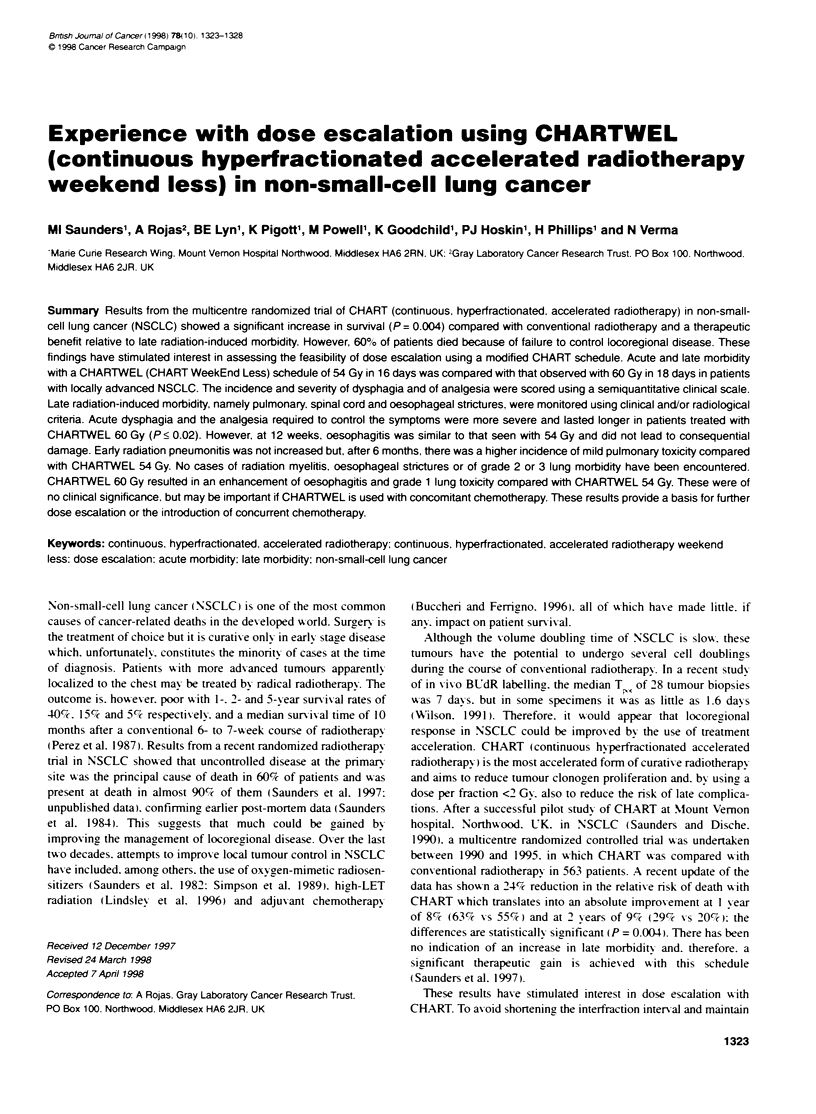
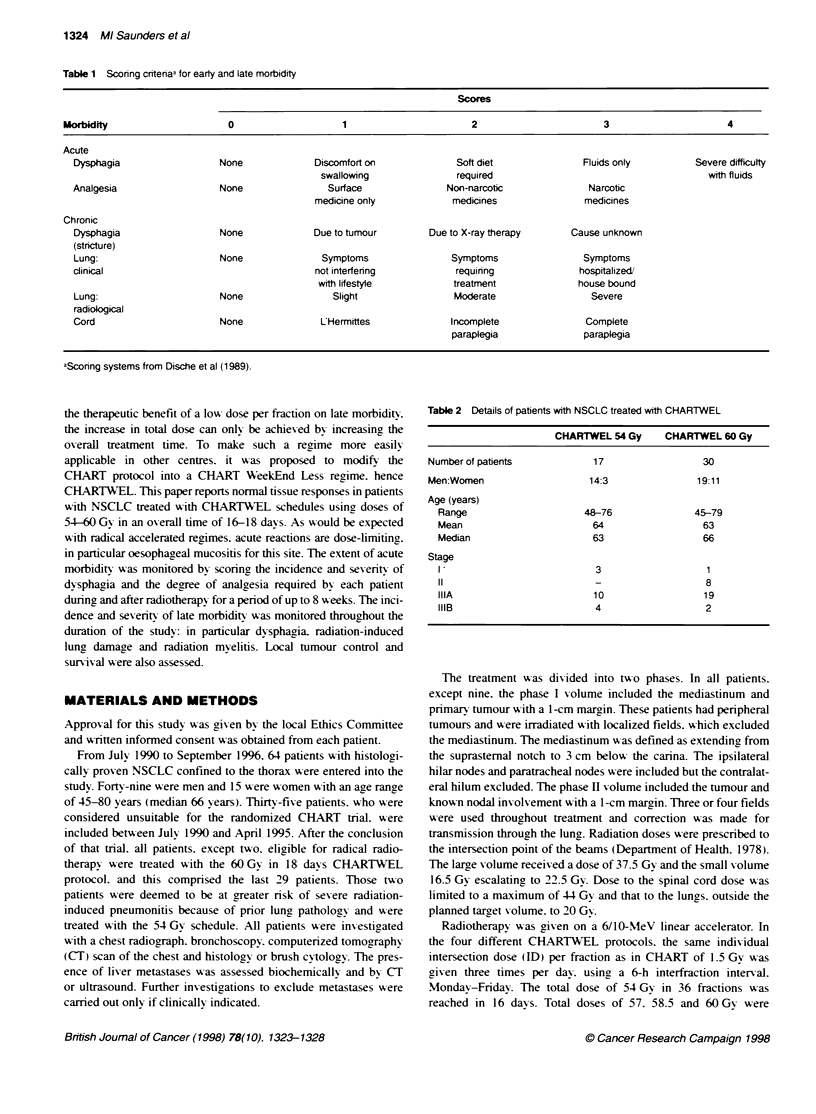
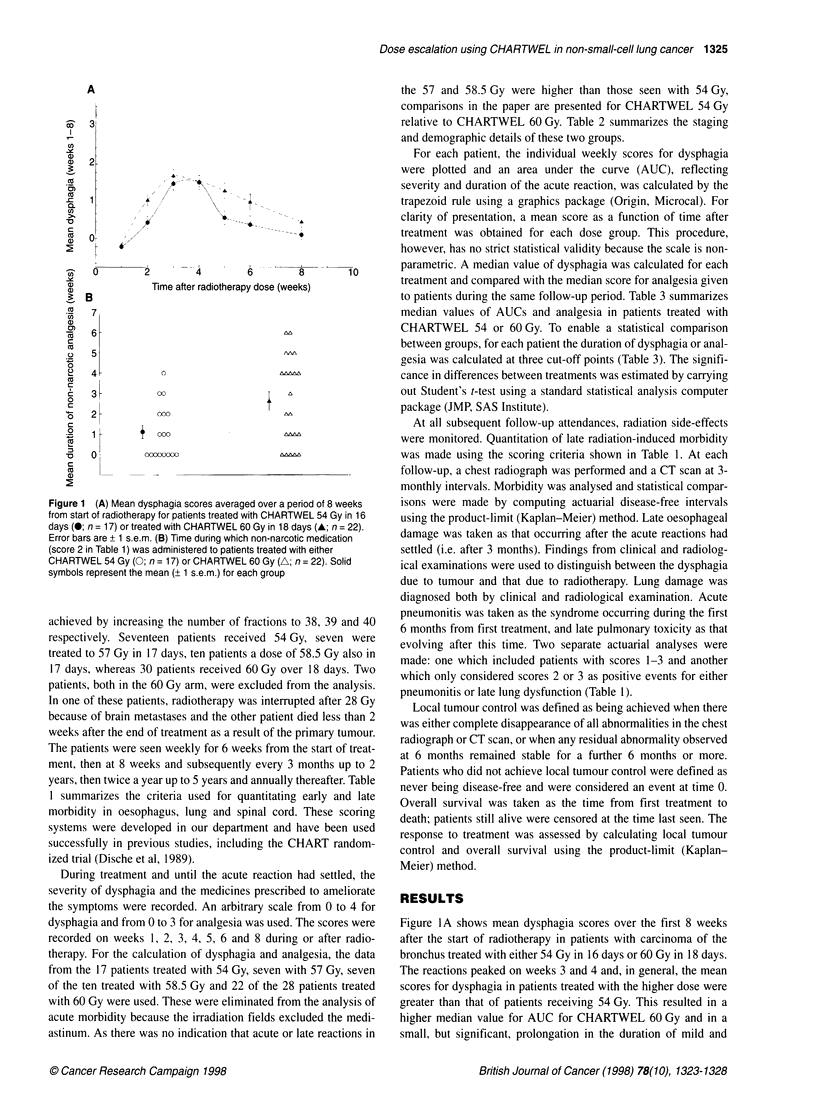
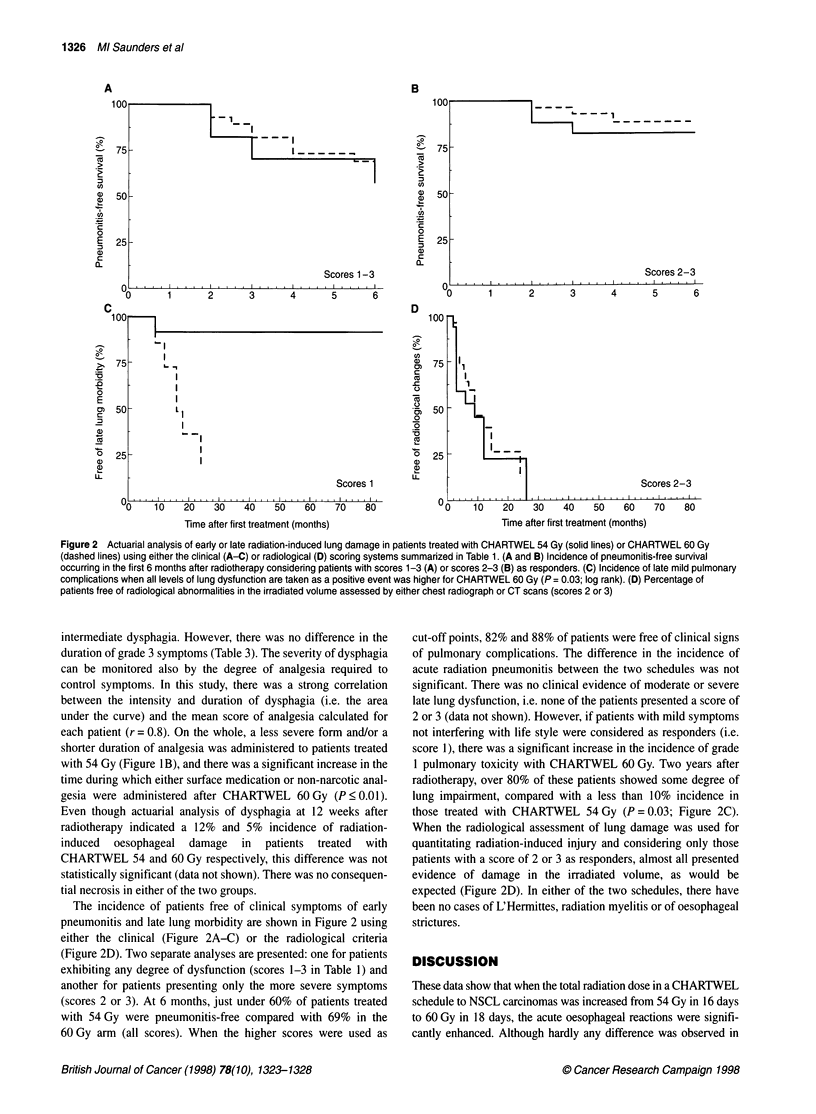
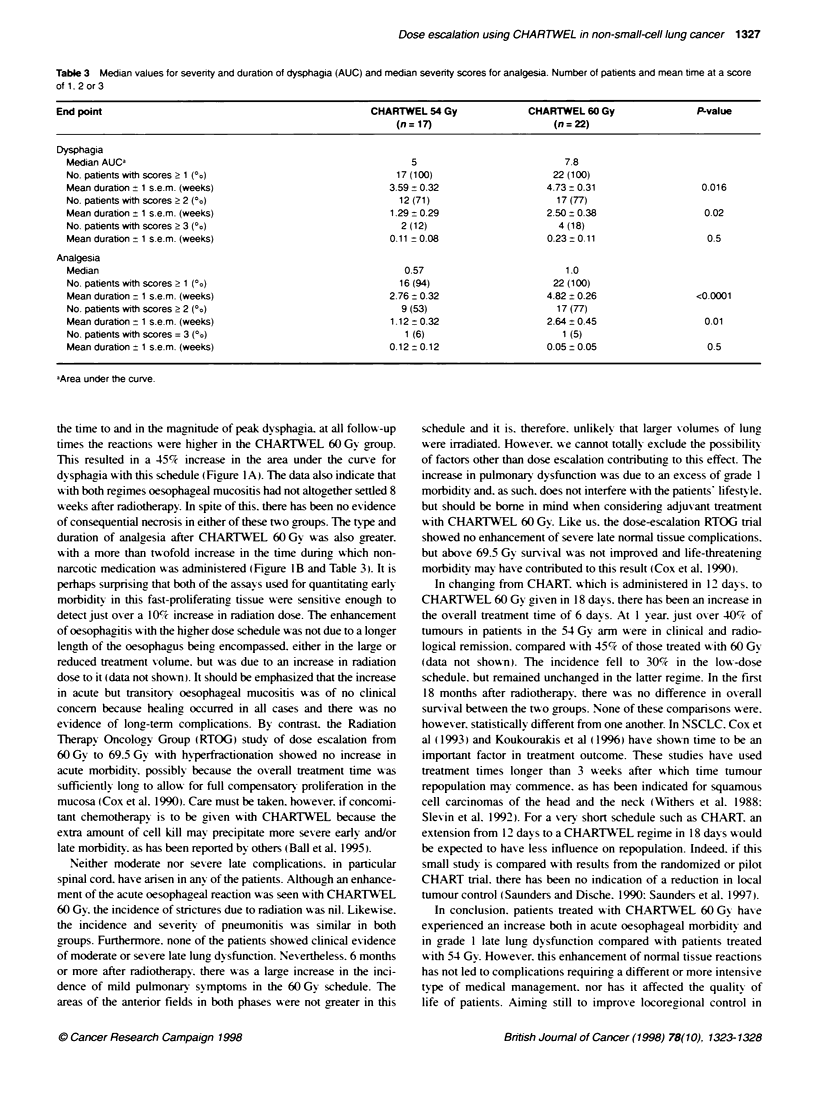

Selected References
These references are in PubMed. This may not be the complete list of references from this article.
- Ball D., Bishop J., Smith J., Crennan E., O'Brien P., Davis S., Ryan G., Joseph D., Walker Q. A phase III study of accelerated radiotherapy with and without carboplatin in nonsmall cell lung cancer: an interim toxicity analysis of the first 100 patients. Int J Radiat Oncol Biol Phys. 1995 Jan 15;31(2):267–272. doi: 10.1016/0360-3016(94)E0021-B. [DOI] [PubMed] [Google Scholar]
- Buccheri G., Ferrigno D. Therapeutic options for regionally advanced non-small cell lung cancer. Lung Cancer. 1996 Jun;14(2-3):281–300. doi: 10.1016/0169-5002(96)00554-5. [DOI] [PubMed] [Google Scholar]
- Cox J. D., Azarnia N., Byhardt R. W., Shin K. H., Emami B., Pajak T. F. A randomized phase I/II trial of hyperfractionated radiation therapy with total doses of 60.0 Gy to 79.2 Gy: possible survival benefit with greater than or equal to 69.6 Gy in favorable patients with Radiation Therapy Oncology Group stage III non-small-cell lung carcinoma: report of Radiation Therapy Oncology Group 83-11. J Clin Oncol. 1990 Sep;8(9):1543–1555. doi: 10.1200/JCO.1990.8.9.1543. [DOI] [PubMed] [Google Scholar]
- Cox J. D., Pajak T. F., Asbell S., Russell A. H., Pederson J., Byhardt R. W., Emami B., Roach M., 3rd Interruptions of high-dose radiation therapy decrease long-term survival of favorable patients with unresectable non-small cell carcinoma of the lung: analysis of 1244 cases from 3 Radiation Therapy Oncology Group (RTOG) trials. Int J Radiat Oncol Biol Phys. 1993 Oct 20;27(3):493–498. doi: 10.1016/0360-3016(93)90371-2. [DOI] [PubMed] [Google Scholar]
- Dische S., Warburton M. F., Jones D., Lartigau E. The recording of morbidity related to radiotherapy. Radiother Oncol. 1989 Oct;16(2):103–108. doi: 10.1016/0167-8140(89)90026-1. [DOI] [PubMed] [Google Scholar]
- Koukourakis M., Hlouverakis G., Kosma L., Skarlatos J., Damilakis J., Giatromanolaki A., Yannakakis D. The impact of overall treatment time on the results of radiotherapy for nonsmall cell lung carcinoma. Int J Radiat Oncol Biol Phys. 1996 Jan 15;34(2):315–322. doi: 10.1016/0360-3016(95)02102-7. [DOI] [PubMed] [Google Scholar]
- Perez C. A., Pajak T. F., Rubin P., Simpson J. R., Mohiuddin M., Brady L. W., Perez-Tamayo R., Rotman M. Long-term observations of the patterns of failure in patients with unresectable non-oat cell carcinoma of the lung treated with definitive radiotherapy. Report by the Radiation Therapy Oncology Group. Cancer. 1987 Jun 1;59(11):1874–1881. doi: 10.1002/1097-0142(19870601)59:11<1874::aid-cncr2820591106>3.0.co;2-z. [DOI] [PubMed] [Google Scholar]
- Saunders M. I., Anderson P., Dische S., Martin W. M. A controlled clinical trial of misonidazole in the radiotherapy of patients with carcinoma of the bronchus. Int J Radiat Oncol Biol Phys. 1982 Mar-Apr;8(3-4):347–350. doi: 10.1016/0360-3016(82)90637-x. [DOI] [PubMed] [Google Scholar]
- Saunders M. I., Bennett M. H., Dische S., Anderson P. J. Primary tumor control after radiotherapy for carcinoma of the bronchus. Int J Radiat Oncol Biol Phys. 1984 Apr;10(4):499–501. doi: 10.1016/0360-3016(84)90029-4. [DOI] [PubMed] [Google Scholar]
- Saunders M., Dische S., Barrett A., Harvey A., Gibson D., Parmar M. Continuous hyperfractionated accelerated radiotherapy (CHART) versus conventional radiotherapy in non-small-cell lung cancer: a randomised multicentre trial. CHART Steering Committee. Lancet. 1997 Jul 19;350(9072):161–165. doi: 10.1016/s0140-6736(97)06305-8. [DOI] [PubMed] [Google Scholar]
- Simpson J. R., Bauer M., Perez C. A., Wasserman T. H., Emami B., Doggett R. L., Byhardt R. W., Phillips T. L., Mowry P. A. Radiation therapy alone or combined with misonidazole in the treatment of locally advanced non-oat cell lung cancer: report of an RTOG prospective randomized trial. Int J Radiat Oncol Biol Phys. 1989 Jun;16(6):1483–1491. doi: 10.1016/0360-3016(89)90953-x. [DOI] [PubMed] [Google Scholar]
- Slevin N. J., Hendry J. H., Roberts S. A., Agren-Cronqvist A. The effect of increasing the treatment time beyond three weeks on the control of T2 and T3 laryngeal cancer using radiotherapy. Radiother Oncol. 1992 Aug;24(4):215–220. doi: 10.1016/0167-8140(92)90226-k. [DOI] [PubMed] [Google Scholar]
- Wilson G. D. Assessment of human tumour proliferation using bromodeoxyuridine--current status. Acta Oncol. 1991;30(8):903–910. doi: 10.3109/02841869109088242. [DOI] [PubMed] [Google Scholar]


